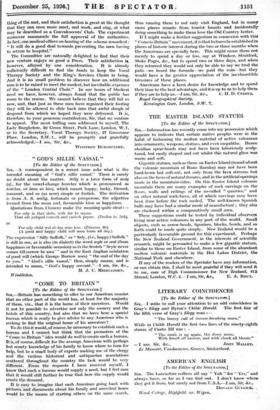THE EASTER ISLAND STATUES
[To the Editor of the SPECTATOR.]
Sra,—Information has recently come into my possession which appears to indicate that certain native peoples were in the habit of fashioning the molten material of active volcanoes into ornaments, weapons, statues, and even megaliths. Hence obsidian spear-heads may not have been laboriously sculp- tured, but easily shaped and cut whilst this natural glass was warm and soft.
Gigantic statues, such as those on Easter Island (round-about the volcanic mountain of Rano Raraku) may not have been hard-hewn but soft-cut, not only from the lava streams but also on the faces of natural fissures, and in the artificial openings made in the mountain-sides. On this Easter Island volcanic mountain there are many examples of rock carvings on the floors, walls and ceilings of the so-called " quarries," and on other natural rock-faces, all of which carvings may have been done before the rock cooled. The well-known Spanish hulls may have had a similar mode of manufacture ; they also are clustered within a comparatively small area.
These suggestions could be tested by individual observers living near active volcanoes in any part of the world. Small objects, such as arrow-heads, figurines, blocks, bowls, and so forth could be made quite simply. New Zealand would be a particularly favourable ground for this experiment. Perhaps the New Zealand Government, in the interests of scientific research, might be persuaded to make a few gigantic statues, similar to those on Easter Island, from some of the abundant molten volcanic materials in the Hot Lakes District, the National Park and elsewhere.
If any of the readers of the Spectator have any information, or can obtain this, I shall be most grateful if they will send it to me, care of High Commissioner for New Zealand, 415
Strand, London, W.C. 2.—I am, Sir, &c., E. A. ROUT.


































 Previous page
Previous page